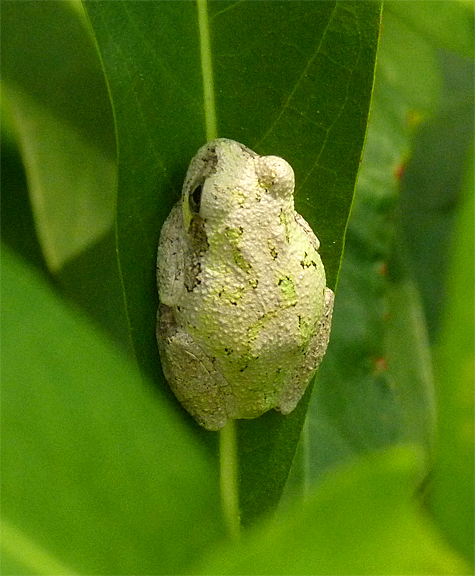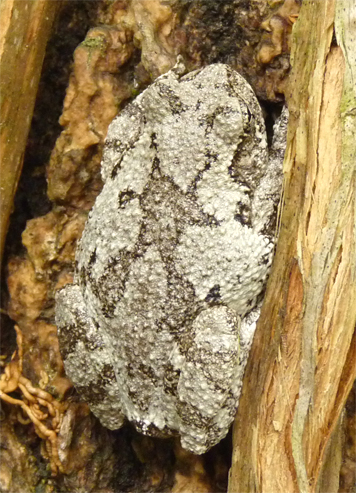Another good spot by Hannah of Outdoor Summer Camp fame on yet another Wednesday walk-about with the campers (8/3/11). This time it was a very light Cope’s Gray Treefrog in the smartweed in Explore the Wild.

As you can see (above and below), these gray treefrogs are highly variable. They are able to change according to the substrate, or object that they happen to be perched upon. I’ve never seen this color change occur as rapidly as an Anole’s color change but it does occur.


It’s safe to say that a gray treefrog, with its camouflage, is capable of concealing itself in a number of different settings.
———————–
Where did this little frog get its name, Cope’s Gray Treefrog? The frog is named for E. D. Cope. Edward Drinker Cope was a 19th century paleontologist and comparative anatomist. He was also an herpetologist. He is perhaps best known as a principal in the infamous “Bone Wars” of that time period, along with O. C. Marsh (also a paleontologist). Bone Wars was a not so friendly bone collecting, fossil finding, species naming rivalry between the two men that appears to have been less than professional.
The late 19th century was a time of great discovery as train loads full of fossils made their way from western states to museum basements back east. Many previously unknown species were unearthed and these two men were in the forefront of many of those discoveries. Cope named 56 new dinosaur genera and species and Marsh eighty.
Both men spent much time and money trying to outdo one another in their quest to discover and name new dinosaur fossils. Here’s a link to more discussion on the matter from the Academy of Natural Sciences in Philadelphia, PA, where Cope was affiliated. However, if you Google “Bone Wars” you’re likely to get several, more juicy, accounts of the two men’s adventures in paleo-one-upmanship.
Incidentally, both men were responsible for placing the wrong skulls onto different dinosaur fossils. Cope’s was the Elasmosaurus, a long necked sea creature which looked similar to what you might imagine the Loch Ness Monster to be (Nessie may indeed be an Elasmosaurus). Cope didn’t actually place the wrong head on an Elasmosaurus skeleton but the right head on the wrong end of the creature. He initially placed the head on the rather short tail end of an Elasmosaurus sleleton instead of on the very long neck end, thinking that the creature would naturally have a longer tail than it would neck.
Marsh’s famous mistake has to do with a more familiar creature than is the Elasmosaurus. He, Marsh, put the wrong head on an Apatosaurus, calling it Brontosaurus. Since no head was available at the time for the very large specimens on hand, Marsh assummed that such a large creature would obviosuly have a large head. He had one made from pieces of other like dinosaurs. That’s a very simplified version of what happened, but you can read more on the subject at Apologetics Press.
The treefrog and its name? There are two species of gray treefrog, Common Gray Treefrog and Cope’s Gray Treefrog which were once thought to be the same species. They are identical in appearance. Both are essentially gray, although variable as seen above. The calls of the two differentiate them for most of us, the Cope’s being higher pitched and more rapid than the Common Gray Treefrog.
The number of chromosomes each possesses, 48 (tetraploid) for the Common and 24 (diploid) for the Cope’s, separate the species for those who look at such things in the lab. I’m not sure what the chromosome difference means beyond the fact that the two gray treefrogs can not successfully breed with one another. I suppose though, that that’s all I need to know.
E. D. Cope described a specimen of gray treefrog in 1880 and this, the diploid species, was given his name.
Last weekend in New Bern I was removing a mostly dead ten-year-old pampas grass stand. It was full of “palmetto bugs” and one fat toad who came back repeatedly over two days apparently in disbelief that his fat days were coming to an end. I have searched Google images for this creature to no avail. He was the color of red clay, although not living in red clay soil. He/she had very round black polka-dots spaced out over the body. It was larger than a good sized plum. Can you tell me anything about this reptile?
Not having seen the toad it’s not easy for me to say what it was that you saw. My first thought was American Toad (Bufo Americanus) which are quite often reddish in color, but you’re down in New Bern which might be out of range for that particular species.
You probably saw a Southern Toad (Bufo terrestris) which is more common on the coastal plain. Southern toads may also be reddish in color but can also be anywhere from tan to brown, and gray to almost black.
The shape and size of the glands on top of the head and behind the eye can help distinguish the two toads from each other.
There are also Fowler’s Toads (Bufo fowleri) and Oak Toads (Bufo quercicus) in your area.
If possible, get a photo to of any unknown species that you come across. Try to get photos from as many angles as you can.
Good luck!